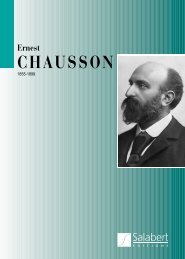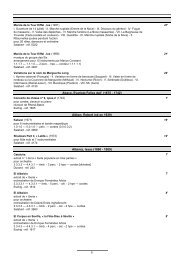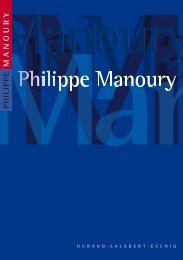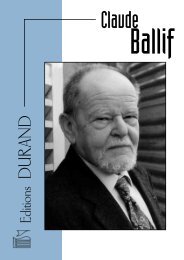Arthur Honegger - durand-salabert-eschig
Arthur Honegger - durand-salabert-eschig
Arthur Honegger - durand-salabert-eschig
Create successful ePaper yourself
Turn your PDF publications into a flip-book with our unique Google optimized e-Paper software.
Prélude,<br />
Fugue,<br />
Postlude<br />
from Amphion<br />
(1948)<br />
As suits the chosen subject and the personality of the author<br />
poet, Amphion, the first (preceding Sémiramis) of two<br />
collaborations between <strong>Honegger</strong> and Paul Valéry, is a score<br />
that has a notably more classical though no less powerful<br />
language. It is essential that the complete score be one day<br />
rediscovered. Composed in 1929 for Ida Rubinstein who<br />
first performed the title role at the Paris Opera on 23 June<br />
1931, this is forty-minute work for reciter, solo baritone,<br />
vocal soloists, chorus and orchestra that recounts the double<br />
creation of Music and Architecture by Amphion, playing on<br />
the lyre given to him by Apollo.<br />
I should like here to draw attention to the purely orchestral<br />
triptych that <strong>Honegger</strong>, much later, in 1948, extracted<br />
from the last three scenes under the title Prélude, Fugue,<br />
Postlude. This is one of the composers finest symphonic<br />
pieces, an ideal concert opener, and yet it is never heard<br />
and was only recorded two times, in 1952 and in 1991.<br />
The language here is tonal though it has an unparalleled<br />
mobility of modulation, linking dominants with ease and<br />
freshness. The Prélude is divided into two parts, the first<br />
slow, the great ‘sidereal’ chords of the opening soon making<br />
way for a long expressive saxophone melody, the second<br />
composed in the manner of a toccata, the counterpoint<br />
endlessly varied with simple scales at different speeds (for<br />
the creation of Music) and soon crowned by the glorious<br />
return of the broad opening melody. There then follows<br />
without a break the Cyclopean Fugue (the creation of<br />
Architecture, the stones joining in the call of Music), one<br />
of the most powerful and skilful in all the symphonic<br />
repertory, worthy of comparison with that of the finale of<br />
Bruckner’s Fifth Symphony, which it at times recalls. An<br />
athletic main subject of no fewer than seven bars, with<br />
choppy rhythms and wide intervallic leaps, is joined by<br />
two countersubjects with superb melodic profiles, that are,<br />
subsequently, developed on their own. The Fugue leads to<br />
a grandiose broadening out, pushing back imperceptibly<br />
to the Postlude, of penetrating melancholy (once more we<br />
have the so expressive voice of the saxophone!), in the course<br />
of which Amphion lets himself be led on by the mysterious<br />
silhouette of a veiled woman: Love or Death, who knows?<br />
The bitter conclusion of the poet and the composer is that,<br />
once the work is over, the creator is no longer of interest.<br />
16

















